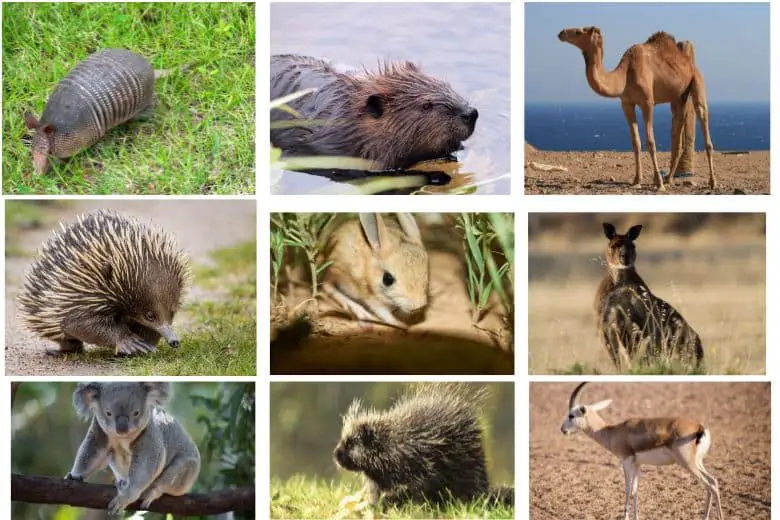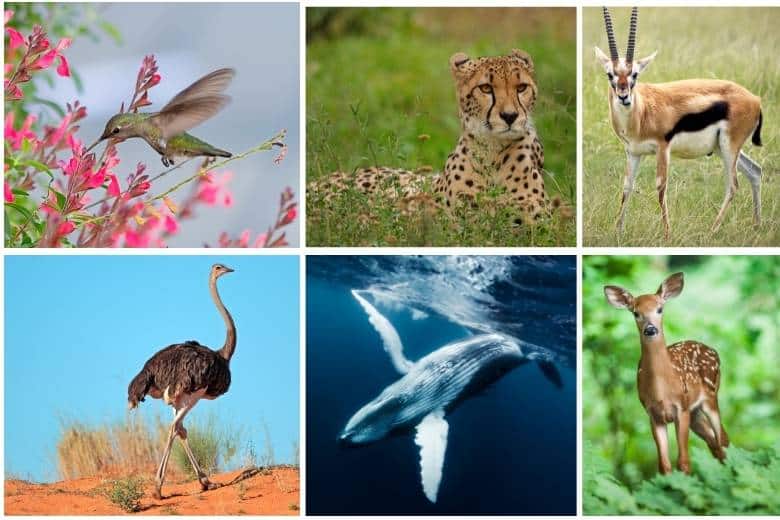Water is essential for the survival of all animals. It is necessary for the proper functioning of all of an animal’s organs and tissues. In addition, water helps to regulate an animal’s body temperature and provides a medium in which chemical reactions can take place.
Without water, animal life would be very different. Animals would have to find other sources of hydration, and many would not be able to survive. Some animals might be able to live off of dew or rain, but many would quickly dehydrate and die.
But, some animals can live without water for extended periods of time, depending on the animal. In this article, I will explore how different animals are able to live without water for different periods of time. We will also explore how these animals find water when they need it.
1. Armadillo
The armadillo is a small mammal that is found in the southern United States, Central America, and South America. Armadillos are known for their hard, protective shells. These shells help to protect them from predators and the elements.
Armadillos are insectivores, meaning that they primarily eat insects. However, they will also eat other small animals, fruits, and vegetables. Armadillos typically dig small holes in the ground in search of food.
Armadillos can live without water for long periods of time. They get the majority of the moisture they need from the food they eat. When they do drink water, they often do so from puddles or ponds.
2. Beaver
The beaver is a large, nocturnal, semi-aquatic rodent. It is the largest member of the rodent family and can grow up to four feet in length and weigh over 60 pounds. The beaver has a thick, brown fur coat which helps to keep it warm in its cold, wet habitat. The beaver’s large, flat tail is used to store fat and help the animal swim. The beaver is a very good swimmer and can stay underwater for up to 15 minutes.
The beaver’s diet consists mostly of plants and tree bark. The beaver will fall a tree with its strong teeth and then strip the bark off to eat. The beaver will also eat the leaves and twigs of trees and shrubs. In the winter, when food is scarce, the beaver will eat its own stored fat.
The beaver is able to live without water for long periods of time. The beaver’s fur coat helps to keep the animal warm and dry in its cold, wet habitat. The beaver’s large, flat tail is used to store fat and help the animal swim. The beaver is a very good swimmer and can stay underwater for up to 15 minutes.
3. Camel
The camel is a mammal that is native to the deserts of Asia and Africa. Camels are well-adapted to their desert habitat and can live for long periods of time without food or water.
Camels are herbivores and their diet consists mostly of grasses and other vegetation. In order to get enough water, camels drink from large pools of water or from plant roots. They also get water from the food they eat.
Camels are able to live without water for long periods of time due to their camelid hemoglobin. This protein helps to keep their red blood cells from shrinking when they are dehydrated.
4. Echidna
The echidna is a small, spiny mammal found in Australia and New Guinea. It is the only mammal that lays eggs. The echidna is related to the platypus.
The echidna’s diet consists of ants and termites. It uses its long, sharp tongue to lick up these insects.
The echidna does not need to drink water as it gets all the moisture it needs from its diet.
5. Jerboa
The Jerboa is a small rodent–like creature found in the deserts of North Africa and Asia. These animals are well–adapted to life in the desert and can go for long periods of time without water. The Jerboa‘s diet consists mostly of plants and insects. These animals are nocturnal and use their long hind legs to jump around in the desert.
6. Kangaroo Rat
The kangaroo rat is a small, rodent–like creature found in the deserts of North America. These animals are well–adapted to their arid environment and can go their entire lives without drinking water. Their diet consists mostly of seeds and other plant material, which they obtain by foraging in the desert. Kangaroo rats are able to extract all the water they need from the plants they eat, and as a result, they produce very little urine. This helps them to conserve water and survive in their dry habitat.
7. Koala
The koala is a small, furry marsupial with a big head, small ears, and large, spoon-shaped noses. They are found in the eucalyptus forests of Australia and sleep up to 20 hours a day.
Koalas are herbivores that eat eucalyptus leaves. They have a slow digestive system that breaks down the toxic chemicals in the leaves. As a result, they consume a lot of leaves (up to 2 kg per day) and spend most of their time resting in the trees.
Koalas get most of the water they need from the eucalyptus leaves they eat. However, they will drink water if it is available. During dry periods, koalas may eat more leaves to increase their water intake.
8. Porcupine
Porcupines are rodents with sharp quills on their backs. These quills are used for self-defence and are very sharp. Porcupines are mostly nocturnal animals and are very shy. They are mostly found in North America, but can also be found in South America and Africa.
Porcupines eat mostly plants and vegetables, but can also eat small animals. They have a good sense of smell and hearing, but poor eyesight. Porcupines can live without water for a long time, but will eventually die if they do not have any water.
9. Sand Gazelle
The sand gazelle is a species of gazelle found in North Africa. The sand gazelle is adapted to living in the desert and can go without water for long periods of time. The sand gazelle is a herbivore and feeds on plants and grasses.
10. sloth
The sloth is a small mammal found in the tropical forests of South and Central America. Sloths are known for their slow movements and their long, curved claws.
Sloths are herbivorous animals that feed on leaves, fruits, and buds. They are able to survive without water for long periods of time due to their low–energy diet. Sloths are able to live without water by absorbing moisture from the air and from the food they eat.
11. Tarsier
The tarsier is a small, nocturnal primate that is found in the forests of Southeast Asia. These animals are known for their large eyes and long, furry tails. Tarsiers are insectivores, meaning that they primarily eat insects. However, they will also consume other small animals, such as lizards and rodents. In terms of their water needs, tarsiers get most of the moisture they require from the food they eat. However, they will drink water if it is available.
12. Tasmanian devil
The Tasmanian devil is a small marsupial found only on the island of Tasmania in Australia. The Tasmanian devil is the largest carnivorous marsupial in the world and is known for its powerful jaws and sharp teeth. The Tasmanian devil is an opportunistic feeder and will eat anything from insects to small mammals. The Tasmanian devil is able to go without water for long periods of time and gets most of the moisture it needs from its food.
13. Thorny Devil
The Thorny Devil is an Australian lizard that is covered in spikes. This animal has the ability to change its colour to match its surroundings, and it can live without water for months at a time. The Thorny Devil‘s diet consists of ants, which it catches with its tongue.
15. Tortoise
Tortoises are land-dwelling reptiles of the order of Testudines. Tortoises are shielded from predators by a hard shell composed of bone and keratin. Tortoises can vary in size from a few centimetres to two meters. They are usually diurnal animals with tendencies to be crepuscular depending on the ambient temperatures. They are generally reclusive animals.
Tortoises are herbivorous animals and their diet depends on the species of tortoise. Some tortoises are strictly herbivorous while others are omnivorous. Tortoises generally consume a wide variety of plant matter including leaves, grasses, fruits, and flowers. Some tortoises are known to eat meat on occasion.
Tortoises are capable of surviving without water for long periods of time. They are able to do this because they are able to store water in their bodies and metabolize water very efficiently. Tortoises get the majority of the water they need from the food they eat.
16. Tuatara
The tuatara is a Reptile that is found only in New Zealand. It is the only species of tuatara that is still alive today, and is sometimes called a “living fossil” because it is so similar to reptiles that lived 200 million years ago. The tuatara has a row of spines down its back, and can grow to be about 80 cm (2.6 ft) long.
The tuatara is a carnivore, and its diet includes insects, worms, lizards, and small birds. It is nocturnal, and spends most of the day hiding in burrows or under rocks.
The tuatara can live without water for long periods of time, and gets most of the moisture it needs from the food it eats.
17. Water Holding Frog
The Water Holding Frog is a species of frog that is able to live without water for long periods of time. The frog’s body is able to absorb water from the air and store it in its tissues, allowing the frog to live in dry environments for up to several months. The Water Holding Frog is found in arid regions of Australia and Africa.
The Water Holding Frog’s diet consists primarily of insects. The frog will also eat spiders, scorpions, and small lizards.
The Water Holding Frog is able to live without water for long periods of time due to its ability to absorb water from the air and store it in its tissues. The frog’s body is covered in a thin layer of mucus that helps to keep the frog’s skin moist. The frog also has special glands in its body that help to extract water from the air.
18. wombat
The wombat is a small, burrowing marsupial native to Australia. They are nocturnal animals, coming out at night to feed on a diet of grasses, roots, and other vegetation. They are relatively solitary creatures, only coming together to mate.
Wombats are well-adapted to living in arid conditions and can go for long periods without water. They get most of the moisture they need from the plants they eat. When water is scarce, they are able to extract moisture from the ground by digging holes and sucking up the water that seeps in.
19. Worm
Worms are small, segmented animals that live in the soil. They are an important part of the ecosystem, aerating the soil and breaking down organic matter. Worms typically eat dead plants and animals, but some species are carnivorous and will eat small insects and other animals. Worms have a simple digestive system and do not need to drink water, as they absorb it through their skin.
20. Xerus
The Xerus is a small rodent-like creature found in Africa. It has a reddish-brown coat and is about the size of a house cat. The Xerus is a herbivore, eating mostly plants and fruits. It is able to live without water for long periods of time, getting the moisture it needs from its food.



